 |
| Category: Flags |

|
|
|
|
|
|
Colours, Guidons
& Streamers of the United States Army |
|
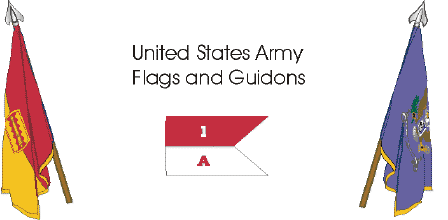
|
|
United
States Army flags traditionally have been used for purposes of
identification and the fostering of esprit de corps. The present
policies stem from ideas and practices dating back to the Revolutionary
War. In turn, those were influenced by the military traditions of
Western Europe to a great extent. The English, French, Dutch, Spanish,
and others brought to North America their flags, military uniforms and
other official symbolism. Leaders of the colonists were familiar with
military traditions and those of England and France, particularly.
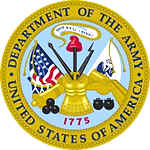 |
With
the Declaration of Independence and the formation of troops, came the
need for items to identify the soldiers and military units.
On February
20, 1776, Washington’s headquarters issued as order on flags quoted,
in part, below: |
"As it is necessary that every Regiment should be furnished
Colours, and that those Colours should…bear some kind of similitude to
the Uniform of the regiment to which they belong, the Colonels… may
fix upon such as are proper, the standard (or Regimental Colours) and
Colours for each Grand Division, …The Number of the Regiment is to be
mark’d on the Colours, and such a Motto, as the Colonel may choose, in
fixing upon which, the General advises a Consultation amongst them. The
Colonels are to delay no time, in getting this matter fix’d, that the
Quarter Master General may provide the Colours as soon as
possible;…"
This
order emphasized the significance of organizational colours to the Army
by directing expeditious design and procurement; delegated
responsibility for design and procurement and prescribed design pattern
elements. |
|
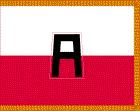
|
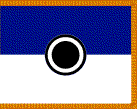
|
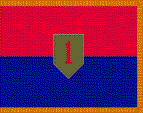
|
|
Armies
|
Corps
|
Infantry Divisions
|
|
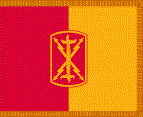
|
Organizational Flags
|
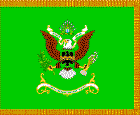
|
|
Separate Brigade
|
|
Regiments
& Separate Battalions
|
Guidons
|
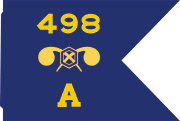
|

|
|
Companies
of Separate Battalions - Chemical
|
Separate
TOE unit without
Branch
Insignia
|
|
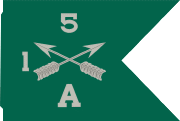
|
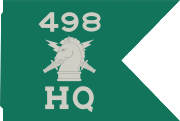
|
|
Companies
of a Battalion of Regiments Special Forces
|
HQ
Company of a Separate Battalion Psychological Operations
|
|
CAMPAIGN, WAR SERVICE
AND UNIT AWARD STREAMERS
|
|
1. BACKGROUND. a.
Battle honours were first depicted by inscribing the names of battles on
the organizational colour or guidon. On 25 August 1861, Major General John
C. Fremont, commanding the Western Department, commended troops from Iowa,
Kansas, and Missouri for their extraordinary service in the battle of
Wilson's Creek, near Springfield, Missouri which had occurred 10 days
earlier. The Union soldiers had fought a Confederate force five times as
large and the battle ended in a moral victory for the Union Army. Fremont
ordered the word "Springfield" to be emblazoned on the colours of
the units involved in the fighting.
b. General Order 19, War Department, 22
February 1862, prescribed that there should be inscribed upon the colour or
guidons of all regiments and batteries the names of the battles in which
they had borne a meritorious part.
c. On 7 February 1890, the use of inscribed
battle honours upon the national and regimental colours was discontinued and
engraved silver rings, now called silver bands, were authorized. This
practice continued until 1918 when the silver bands were in short supply
and the War Department authorized the Commanding General, American
Expeditionary Forces (Gen. John J. Pershing) to locally procure ribbon as
a substitute and inscribe on the ribbon strips the name of special battles
and major operations that colour bearing units of the AEF had been engaged
in during World War I. These ribbon strips became the forerunners of our
present day campaign streamers.
d. Hand embroidered silk streamers were
introduced on 3 June 1920. The original directive prescribed that there
would be a silk streamer for each war in which the organization
participated in the theatre of operations and to be the colour of the
campaign ribbon for the different wars. The name of the battle or campaign
of a war was embroidered on the ribbon.
e. Unit award streamers were also first
authorized in 1920 when the War Department authorized a blue silk streamer
with the name of the action embroidered thereon. The streamer was adopted
to reflect organizations "Mentioned In Orders" by the War
Department for meritorious service in action.
2. CURRENT STREAMERS/DECORATIONS.
Only
campaign streamers are displayed on the Army flag and they are 2 3/4
inches wide and 4 feet long. Streamers (2 3/4 inches wide and 3 feet in
length) are currently authorized for display by organizations authorized a
distinguishing flag to indicate the following:
a. Campaign Streamers.
The streamer
reflects campaign participation credit and is the campaign or service
ribbon design authorized for the soldiers for that specific conflict or
operation during the period. Organizations display the streamers on the colours
for campaigns or service for which they have received campaign
participation credit as shown on the unit's lineage and honours. The
inscription is as shown on the unit's lineage and honours/statement of
service. Campaign streamers displayed by organizations do not have the
date of the campaign embroidered on the streamer unless it is part of the
name (e.g. Mexico 1916-1917). The 174 campaign streamers displayed on the
Army flag include the date of the action:
|
 |
How the
Streamers are
displayed
|
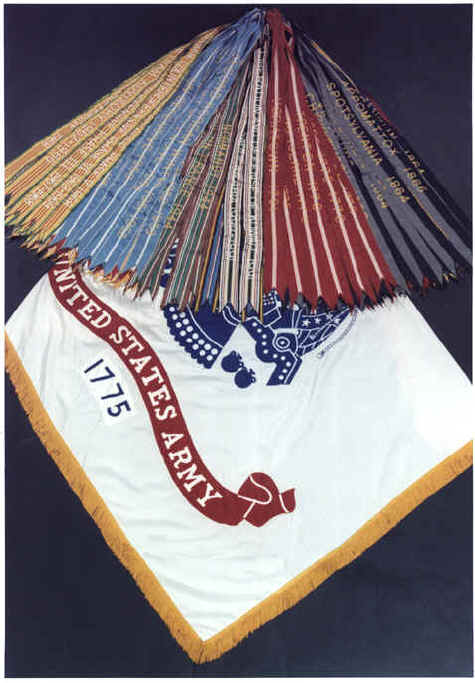 |
The Army
Flag and it's Streamers
The 174 streamers attached to the
Army Flag staff denote campaigns fought by the Army throughout our
nation’s history.
Each streamer (2 ¾ inches wide and 4 feet long)
is embroidered with the designation of a campaign and the year(s) in
which it occurred. The colors derive from the campaign ribbon
authorized for service in that particular war.
The concept of campaign streamers
came to prominence in the Civil War when Army organizations
embroidered the names of battles on their organizational colors.
|
| This
was discontinued in 1890, when units were authorized to place silver
bands, engraved with the names of battles, around the staffs of
their organizational colors. When AEF units in World War I were
unable to obtain silver bands, General Pershing authorized the use
of small ribbons bearing the names of the World War I operations. In
1921 all color-bearing Army organizations were authorized to use the
large campaign streamers currently displayed.
"The Army Flag and Its
Streamers" was originally prepared in August 1964 by the Office
of the Chief of Military History, in cooperation with the Office of
the Chief of Information, and the U.S. Army Exhibit Unit, to provide
general summaries of each of the campaigns displayed on the Army
flag. It was subsequently updated by the Center of Military History
to add the campaigns from Vietnam. |
World War I. There
were 13 campaigns for World War I during the period 1917-1918. The
streamer is the World War I Victory Medal ribbon which had a red centre with a rainbow on each side of the
centre stripe and a purple edge. The
double rainbow symbolizes the dawn of a new era and the calm which follows
the storm.

The following inscriptions in white are authorized:
- CAMBRAI 1917
- SOMME DEFENSIVE 1918
- LYS 1918
- AISNE 1918
- MONTDIDIER-NOYON 1918
- CHAMPAGNE-MARNE 1918
- AISNE-MARNE 1918
|
- SOMME OFFENSIVE 1918
- OISE-AISNE 1918
- TPRES-LYS 1918
- ST. MIHIEL 1918
- MEUSE-ARGONNE 1918
- VITTORIA VENETO 1918
|
|
|
WW2 Asiatic Pacific Theatre. There
were 21 campaigns in the Asiatic Pacific Theatre. The Asiatic Pacific
Campaign streamer is yellow with a narrow blue, white and red centre stripe and a narrow white, red and white stripe on each side. The yellow
colour represents Asia; the blue, white, and red stripes taken from the
American Defence Medal refer to the continuance of American Defence after
Pearl Harbor. The red and white stripes are the Japanese colours.

The
following inscriptions in blue are authorized:
- PHILIPPINE ISLANDS 1941-1942
- BURMA 1941-1942
- CENTRAL PACIFIC 1941-1943
- EAST INDIES 1942
- INDIA-BURMA 1942 - 1945
- AIR OFFENSIVE, JAPAN 1942 - 1945
- ALEUTIAN ISLANDS 1942 - 1943
- CHINA DEFENSIVE 1942 - 1945
- PAPUA 1942-1943
- GUADALCANAL 1942-1943
- NEW GUINEA 1943 - 1944
|
- NORTHERN SOLOMONS 1943 - 1944
- EASTERN MANDATES 1944
- BISMARCK ARCHIPELAGO 1943 - 1944
- WESTERN PACIFIC 1944 - 1945
- LEYTE 1944 - 1945
- LUZON 1944 - 1945
- CENTRAL BURMA 1945
- SOUTHERN PHILIPPINES 1945
- RYUKYUS 1945
- CHINA OFFENSIVE 1945
|
|
WW2
European-African-Middle
Eastern Campaign (EAME). There were
16 campaigns in the EAME Theatre. The EAME streamer is green with a brown
stripe on each edge. The centre has a narrow blue, white and red stripe.
On the upper portion is a narrow white and red stripe with a narrow white,
black and white stripe on the lower portion. The brown colour is
representative of the sands of Africa and the green colour for the green
fields of Europe. The central blue, white, and red stripes taken from the
American Defence Medal ribbon refers to the continuance of American Defence
after Pearl Harbor. Green, white, and red are the Italian colours,
and the white and black colours refer to Germany.

The following
inscriptions in yellow are authorized:
- EGYPT-LIBYA 1942-1943
- AIR OFFENSIVE, EUROPE 1942-1944
- ALGERIA-FRENCH MOROCCO 1942
- TUNISIA 1942-1943
- SICILY 1943
- NAPLES-FOGGIA 1943-1944
- ANZIO 1944
- ROME-ARNO 1944
|
- NORMANDY 1944
- NORTHERN FRANCE 1944
- SOUTHERN FRANCE 1944
- NORTH APENNINES 1944-1945
- RHINELAND 1944-1945
- ARDENNES-ALSACE 1944-1945
- CENTRAL EUROPE 1945
- PO VALLEY 1945
|
|
| Korean Service. There
were 10 campaigns for Korean service during the period 1950 - 1953. The
Korean Service streamer is light blue with a white centre stripe and a
narrow white stripe on each edge. The medium blue and white are the colours
of the United Nations referring to the UN mission.
 The following
inscriptions in yellow are authorized:
The following
inscriptions in yellow are authorized:
- UN DEFENSIVE 1950
- UN OFFENSIVE 1950
- CCF INTERVENTION 1950-1951
- FIRST UN COUNTEROFFENSIVE 1951
- CCF SPRING OFFENSIVE 1951
|
- UN SUMMER-FALL OFFENSIVE 1951
- SECOND KOREAN WINTER 1951-1952
- KOREA SUMMER-FALL 1952
- THIRD KOREAN WINTER 1952-1953
- KOREA SUMMER 1953
|
|
| Vietnam Service. There
were 17 campaigns for Vietnam service during the period 1962 - 1973. The
Vietnam Service streamer is yellow with three red stripes through the centre. It has a green stripe on each side. The yellow with red stripes
was suggested by the flag of the Republic of Vietnam. The green alludes to
the jungle.

The following inscriptions in white are authorized:
- VIETNAM ADVISORY 1962 - 1965
- VIETNAM DEFENCE 1965
- VIETNAM COUNTEROFFENSIVE 1965-1966
- VIETNAM COUNTEROFFENSIVE, PHASE II
1966-1967
- VIETNAM COUNTEROFFENSIVE, PHASE III
1967-1968
- TET COUNTEROFFENSIVE 1968
- VIETNAM COUNTEROFFENSIVE, PHASE IV 1968
- VIETNAM COUNTER OFFENSIVE, PHASE V 1968
|
- VIETNAM COUNTEROFFENSIVE, PHASE VI,
1968-1969
- TET 69/COUNTEROFFENSIVE, 1969
- VIETNAM SUMMER-FALL 1969
- VIETNAM WINTER-SPRING 1970
- SANCTUARY COUNTEROFFENSIVE 1970
- VIETNAM COUNTEROFFENSIVE, PHASE VII,
1970-1971
- CONSOLIDATION I 1971
- CONSOLIDATION II 1971-1972
- VIETNAM CEASE-FIRE 1972-1973
|
|
|
Unit
award streamers are used by organizations to indicate the unit has been
awarded a unit decoration. Both foreign and U.S. unit decorations are
reflected through the use of unit award streamers. In addition to the
regular size unit award streamers for display by units on the
organizational flag, unit award streamers (1 3/8 inches wide and 2 feet
long) are displayed by separate companies authorized a guidon. The
inscription and device, if required, will be as indicated on the unit's
lineage and honours. Unit awards for companies of battalions are normally
displayed on the battalion flag.
Army Presidential Unit Citation.
A blue
streamer with the name of the action embroidered in white.
 The streamer
represents a degree of heroism required that would warrant award of the
Distinguished Service Cross to an individual.
It is accompanied by the emblem
The streamer
represents a degree of heroism required that would warrant award of the
Distinguished Service Cross to an individual.
It is accompanied by the emblem

which is worn by all members of the Unit (for life by the soldiers
involved and while in the Unit by later arrivals)
- Aussie Units awarded this honour
include 3RAR (Kapyong) D/6RAR (Long Tan) and AATTV
|
| Army Meritorious
Unit Commendation Streamer. The streamer is red and has the inscription
embroidered in white letters.

The degree of achievement required is the
same as that which would warrant a Legion of Merit
to an individual. It is accompanied by the
emblem

which
is worn by all members of the Unit (for life by the soldiers involved and
while in the Unit by later arrivals)
- Aussie Units awarded this honour
include 1RAR (for service with US 173rd Airborne Brigade in SVN) and AATTV members
for service in SVN
|
| Navy
Unit Commendation Streamer for use by Army organizations.

The streamer consists of the following
stripes: blue, yellow, red, green (centre), red, yellow, blue. The
inscription is embroidered in white.
It is accompanied by the
emblem

which
is worn by all members of the Unit (for life by the sailors involved and
while in the Unit by later arrivals)
- Aussie Unit to be awarded this honour
is 3rd Clearance Diving Team RAN for service in SVN
|
| Republic of Vietnam
Gallantry Cross Unit Citation. The streamer has a yellow
centre stripe with a red stripe
on each edge. Eight pairs of thin red lines are on the yellow stripe. The
inscription is white.

A bronze palm is centered between the hoist end of
the streamer and the first letter of the inscription.
It is accompanied by the emblem

which
is worn by all members of the Unit (for life by the soldiers involved and
while in the Unit by later arrivals)
- Aussie Units awarded this honour include
1RAR (awarded but acceptance blocked by Canberra) and ARVN Units that members of AATTV
served with.
|
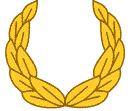 |
Earned
Honour Device. The earned honour device is embroidered in yellow two inches from the end of the
streamer to indicate the battalion of a regiment that has the device
actually participated in the campaign. Prior to the Korean War, if one
battalion of the regiment received campaign credit, all battalions
received campaign credit participation; however, only those battalions
that earned the credit would receive the earned honour device. Since the
Korean War, only those battalions of the regiment that receive campaign
participation credit are authorized to display the streamer. |
 |
Arrowhead
Device. A bronze embroidered
arrowhead is placed 3/4 inch before the inscription on the streamer to
indicate the unit made a parachute jump into enemy territory; participated
in an amphibious landing on enemy territory; or made a helicopter assault
landing in enemy held territory as part of an organized force carrying out
an assigned tactical mission. |
 |
Palm.
The palm is used on some foreign unit awards (e.g. French Croix de Guerre,
Belgian Croix de Guerre, Republic of Vietnam Cross of Gallantry) to
indicate the level of the military command which cited the unit for the
award. The palm indicates the award was made by the Armed Forces
headquarters of the foreign government. The embroidered bronze palm
outlined in green and with green berries is cantered between the hoist end
of the streamer and the first letter of the inscription. |
|

Stars,
1½ inches in diameter, are used to indicate the level of the foreign
military which cited an organization for an award. A gold star represents
citation by a corps, a silver star by a division, and a bronze star by a
brigade/regiment. The embroidered gold, silver and bronze stars are cantered
between the hoist end and the first letter of the inscription on foreign
awards.
A blue embroidered star is placed 1½ inches after the last
letter of the inscription on the combat infantry streamer to indicate
subsequent awards. |
| PLEASE
NOTE: The images of all badges, insignia, decorations and
medals on this web page are protected by Title 18, United States Code,
Section 704 and the Code of Federal Regulations (32 CFR, Part 507).
Permission to use these images for commercial purposes must be obtained
from The Institute of Heraldry prior to their use. |
|